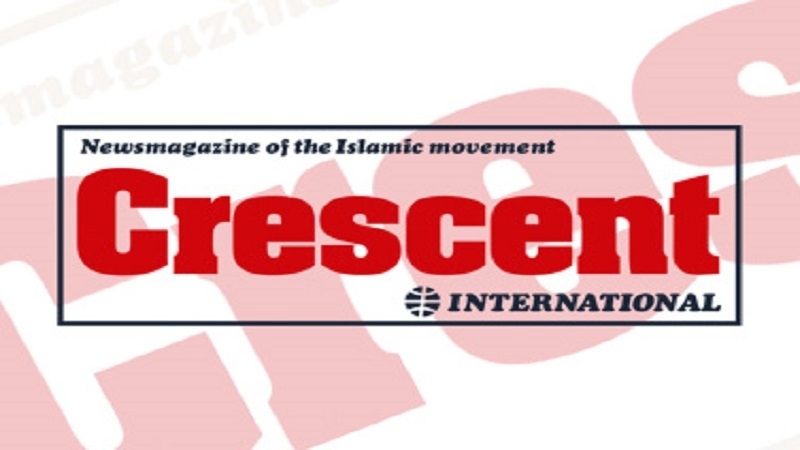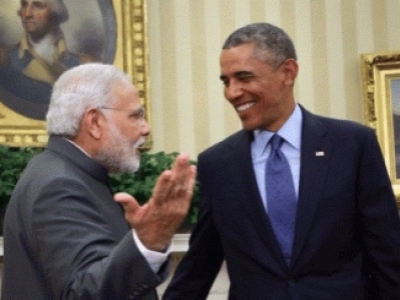Beyond grief: a Hindu's continuing crusade against Islam
Empowering Weak & OppressedZafar Bangash
Rabi' al-Thani 08, 1419 1998-08-01
Book Review
by Zafar Bangash (Book Review, Crescent International Vol. 27, No. 11, Rabi' al-Thani, 1419)
BEYOND BELIEF: ISLAMIC EXCURSIONS AMONG THE CONVERTED PEOPLES By V S Naipaul. Little Brown & Co (UK), London, UK. 1998. pp.439. Hbk: UK20.
The writer, V S Naipaul, like the apostate Salman Rushdie, is much revered in the west. Both are of Indian origin although Naipaul was born in Trinidad where his forefathers were taken as indentured labourers. Suffering from an inferiority complex and rejecting their roots, both poke fun at the culture and values of their own people. Rushdie, a cultural traitor, was born into a Muslim family in Bombay but repudiated his religion - a capital offence in Islam. Naipaul has remained a Hindu.
Both specialise in fiction except when it comes to writing about Islam. They use the medium of fiction-writing to attack the religion of more than 1,000 million adherents worldwide. While Naipaul does not use the kind of abusive language that has made Rushdie such a darling of the west, he is no less venomous in his attacks as his latest book, Beyond Belief, shows. Naipaul, admired for such writings, was knighted by Britain in 1990 for ‘services to literature.’
This book is a sequel to his earlier one published in 1981 titled, Among the Believers. The first journey to four Muslim countries - Indonesia, Malaysia, Pakistan and Iran - was undertaken in 1979. The sequel came after follow-up visits to the same countries in 1995 and discussions with many of the same people. It is essentially a travelogue spiced with critical political comment.
Like most fiction writers, Naipaul’s eye for detail is admirable. He notices the small things and describes them well adding a touch of drama that brings his narrative to life. But one also notices considerable degree of snobbery. He is annoyed by the sounds and smells he encounters in these countries. The son of indentured labourers has clearly forgotten his past. At times, he is confused; he ridicules both Pakistan’s low literacy rate as well as such learning centres as the Ayatullah Marashi Najafi library in Qum, Iran with thousands of rare manuscripts and books.
His lack of knowledge of history as well as his Hindu prejudices against Islam and Muslims stand out glaringly. He writes in the prologue: ‘Islam is in its origins an Arab religion. Everyone not an Arab who is a Muslim is a convert’ (p.1). It is doubtful whether Naipaul would categorise the people of Europe and North America as ‘converts’ to Christianity. Indeed, all religions started at some point in history. In that sense, even the Arabs are ‘converts’ to Islam from paganism. And both Judaism and Christianity are Middle Eastern in origin.
Unlike Judaism and Hinduism but like Christianity, Islam is a universal religion. It is the last revealed Word of God to all mankind. The Prophet, upon whom be peace, was the last and final messenger sent to all humanity.
Hinduism is not an indigenous Indian religion as millions of Dalits would testify. It was brought by the Aryans. It has remained confined to India because of the ubiquitous caste system and institutionalised racism, notwithstanding the Hindu indentured labourers who were taken to work on plantations in such places as the West Indies and South Africa. Before Hinduism, Buddhism was the principal religion in the region.
Quite aside from his prejudices against Islam, Naipaul’s grasp of historical facts is quite appalling, especially given his ‘reputation’ as a writer. He asserts that Islam began to penetrate India some 400 years after its advent (p.264) and that the early Muslims who came (Mahmud Ghaznavi presumably, although Naipaul does not mention his name), were ‘invaders sweeping down from the north-west and looting the temples of Hindustan and imposing the faith on the infidels’ (p.265).
While he does not define it geographically, it is clear that he means the present-day India. Historically, its boundaries have varied; the present boundaries date back to 1947. India - or Hindustan, to use its proper name - has remained a flexible entity. Its boundaries contracted or expanded based on who ruled it.
At certain times in history, its boundaries stretched as far as the eastern parts of Afghanistan. Islam had come to this part of the world including what is the present-day North West Frontier Province of Pakistan, during the lifetime of the Prophet, upon whom be peace. Naipaul’s assertion, therefore, that Islam came 400 years later is historically incorrect.
Similarly, the claim that the invaders ‘forced’ Islam on the infidels, is pure fiction. Only the prejudiced mind of a Hindu can come up with such a statement. Had the forcible conversion theory been true, India today would be a Muslim-majority State. A quick comparison with what the Europeans did to the Native Peoples of North America or the Aborigines in Australia would illustrate what forced conversion and genocide can achieve.
Muslims ruled India for more than 1,000 years. This is long enough to convert all the people to Islam by force, if that is how Islam was spread. In fact, most Muslim rulers, with minor exceptions, were not interested in Islam or spreading it among the subject peoples. Jalaluddin Akbar, the sixteenth century Mughal emperor and grandson of Babur, the dynasty’s founder, not only married a Hindu woman, which is contrary to Islamic injunctions, but also tried to found a new religion. This was an odd mixture of Islam and Hinduism, a monstrosity that never came to fruition.
But Naipaul’s book is not merely about Muslim rule in India even though he laments the ‘break-up’ of India to create Pakistan while applauding the break-up of Pakistan to create Bangladesh (p.267) without mentioning India’s role in it. He starts with the story of Indonesia and then goes on to Malaysia.
Like a good story-teller, he eases from one country to the next without abrupt breaks. This is the fiction-writer in him. There is no specific conclusion drawn at the end of either but the underlying theme is to project Islam as a ‘failure.’ This is most clearly visible when he begins to address socio-economic or political issues.
Naipaul takes pleasure in telling his readers that Indonesia was a Hindu country. The name Indonesia is derived from the word India. But keeping true to his fact-free narration, he does not tell his readers that Indonesia is an artificial entity, nor that no Muslim ‘invader’ ever set foot there, or in Malaysia.
Muslim traders - not invaders with the sword in one hand and Qur’an in the other - brought Islam to Southeast Asia; certainly no coercion involved there. Indonesia today is the most populous Muslim country in the world with more than 200 million inhabitants. Naipaul says that the
‘converts’ - non-Arab Muslims - are torn between two worlds: that of their native culture and the one imposed by the faith.
This is deliberate misrepresentation of Islam whose egalitarianism transcends such constraints. Non-Arab Muslims do not dress like the Arabs, nor eat their food yet it makes them no less Muslim. The Qur’an has established taqwa, not tribe or origin, as the criterion for merit in Islam (49:13).
As proof of Islam’s ‘Arabness’, Naipaul says that all places of Muslim religious significance are in Arabia. Places become religiously important because of the role they play in the development of religion. For Christians, Bethlehem and the Holy Sepulchre in Jerusalem are important because of their association with the life of the Prophet Jesus, upon whom be peace. Does that mean Christianity should be called a Palestinian religion?
Islam is not concerned only with matters personal. It encompasses all aspects of life. While Naipaul is certainly right - and many Muslims would agree with him - that most Muslim countries have failed to live up to Islamic injunctions, the failure is not that of Islam. The most glaring example of failure is in Pakistan for which he blames Islam. This is intellectually dishonest.
There is little Islam in Pakistan except rhetoric. The brown sahibs who assumed the mantle of leadership were the product of British colonialism and training. Naipaul has much in common with them despite his Hindu religion. It is this class of people that have failed so miserably. The author’s theory stands condemned by its own logic.
This is even more apparent in the case of Iran. According to Naipaul, Iran is a ‘convert’ country, yet an Islamic Revolution occurred there and not in an Arab country. The author has failed to explain this apparent paradox. Surely if the Iranians were suffering from Islam’s imperialism, by now they should have rebelled against it. Yet they overthrew the yoke of US imperialism.
In order to cover his illogical claims, he resorts to the conjurer’s trick. There are, in every society, some disgruntled elements. And there are, one must admit, such elements in Iran as well. Some may even have valid reasons for their dissatisfaction. Their number, however, is small. The overwhelming majority of the people in Iran support the system and the government.
Naipaul laments the privileges given to the Basijis (volunteers) who participated in the defence of the country against the Iraqi invasion. After the war, the Basijis, he says, were rewarded with university placements without proper qualifications (p.252). One may ask: what is wrong with that?
Are people who sacrificed their comfort and well-being and were willing to lay down their lives for the sake of the country, not entitled to some benefits compared with those who stayed behind and did not risk anything? Iran’s people-based and supported revolution should have been applauded by Naipaul, yet he condemns it and calls it a ‘failure.’ India, on the other hand, with 350 million people living below the poverty line, is hailed as a ‘success’ story. Similarly, attempts in Indonesia to spread education in the rural areas through pesantren teaching is decried, as are attempts to achieve technological advancement.
Since Naipaul starts with preconceived ideas, he is unable to rise above his prejudices. He sets out to find ‘proof’ for what he has already decided to say although he stays in the background and lets his subjects speak. The choice of who should speak also makes a difference. He attempts to justify this through the metaphor of a train journey; it would not alter description of the landscape regardless of which compartment the person sits in. Human beings are not railway carriages; they have emotions, preferences for likes and dislikes and so on. Why, for instance, did he not interview a supporter of the Revolution to present his case?
Naipaul would be much better off staying with fiction writing. This is what he does best and this is what he has done in this book, despite laying claims to writing about the countries mentioned.




